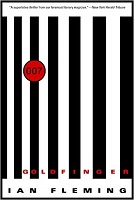Why the things you love belong in your books.

Authors are often encouraged to write about things they like. I presume this advice pertains mainly to nonfiction authors, since it might create a problem for novelists, particularly those in the thriller, mystery, horror, and erotica genres. The distance between imagination and actuality is about the width of a pair of handcuffs.
That being said, there are instances where a writer’s predilections (of the legal, or at least misdemeanor, variety) can be very useful, even entertaining, when incorporated into a novel.
As readers of this space know, I’m a big fan of Ian Fleming’s James Bond books, but not only for the reasons one might assume. Yes, I like the action and the prose, but Fleming often brought a lot more to the table (and often not a baccarat table!).
Fleming was a hedonist. He liked women, gambling, and sedate athletics, basically in that order. Since he wrote at a time when authors were more discreet about sex, Bond’s romps wouldn’t titillate a seminarian today. (Well, not all of them.)
But he was a master at describing things he personally loved: cards, golf, skiing, and underwater swimming. Since the latter two usually involved periods of high danger, when Bond was skiing to get away from killers, or planting a Limpet mine on the hull of some miscreant’s yacht, I’ll concern myself with the card and golf games. (If your bag is planting Limpet mines, my hat is off to you.)
The high-stakes golf game between Auric Goldfinger and James Bond in Goldfinger is probably the most famous of Fleming’s sports descriptions. The wager was a gold bar from a Nazi stash, and Goldfinger cheated to win — but lost to the savvy 007, who, at the last moment, cheated him back.
(My homage to Fleming was an equally long match for $20,000 in Sound of Blood. Cheating was involved, as well as golf shots my friends say only exist in my imagination, since I am not capable of any of them.)
Fleming also wrote brilliantly about bridge and other card games, mainly baccarat and chemin de fer. Many people recall the famous baccarat game in Casino Royale between Bond and Le Chiffre (changed to Texas Hold ‘Em in the 2006 Daniel Craig movie), but my favorite is the bridge game at Blades, an ultra-exclusive London club, in Moonraker. It is priceless, and, like the Casino Royale game, is obviously drawn from Fleming’s own experience as a topnotch card player.
I bet that writers who plug in scenes featuring activities they love have a blast. Of course, not everything lends itself to such flights of fictional fancy. Writing an exciting scene about croquet, for example, might be a stretch. Unless, of course, someone shoots a player during a match.
Many writers are also foodies, and describe meals and drinks that send me to the nearest restaurant. I used to fish a lot, so I’ve also incorporated bass fishing in some of my books. Funny, the bass keep getting bigger over the years.
I would urge writers of fiction to incorporate their hobbies and other favorite activities into their novels. Such diversions don’t have to be lengthy, but they humanize the characters, prose, and plot. I’ve even given my villains some fun things to do.
Incidentally, such descriptions are probably a good way to break through the occasional writer’s block!
Lawrence De Maria, once a Pulitzer-nominated New York Times reporter, could never play for the stakes he writes about. He chokes on a two-foot putt in a three-dollar Nassau. His thrillers and mysteries, both digital and print, are available on Amazon.

